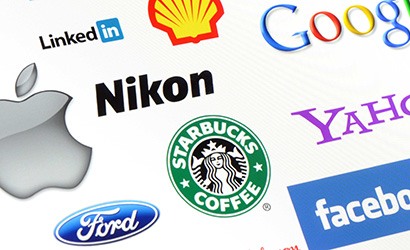People invest a lot of money and effort into building a brand. So why should a company rebrand? Companies have to be diligent about what is happening with their brand and the current business environment. Reasons for rebranding range from negative brand reputation to loss of brand relevancy to legal disputes over the ownership of a brand name. Lets take a look at some examples of rebranding and the rationale behind the changes.
Reasons for a Company Rebrand
Having a negative reputation in the market place
A company with a negative image will have to decide if it can overcome the negativity or rebrand. Apple rebranded in 1997, recognizing the need to rebrand the company from the key messaging and customer promise right down to changing the color of the logo from rainbow to solid gray. Apple did not change the icon since it had already developed strength and brand awareness. Their rebranding was not a total overhaul but a strategic message shift that the brand had changed.
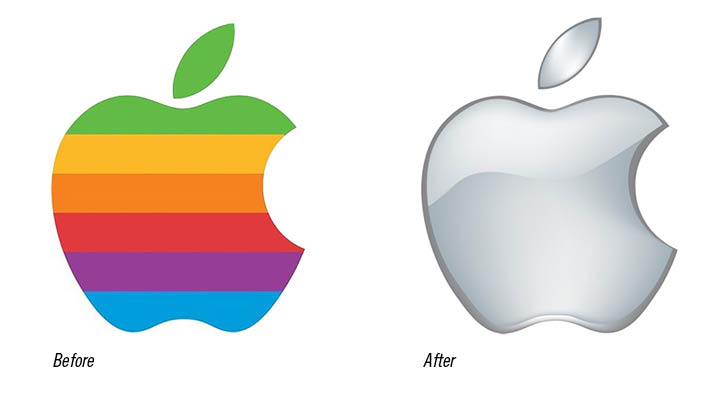
Here are some the reasons Apple decided to rebrand:
- Steve Jobs rejoined the board
- Apple stock was down to $77 a share
- Microsoft was winning the battle for the market share
A company doesn’t own the legal rights to it’s name.
Sometimes, even after many years, a company pops up with the same name that another company has been using in the same time frame. When the first company takes legal action and wins the second company has to rebrand.
For example, in 2009 Gama Foods brought a suit against Mission Burrito restaurants for violation of the Gama Foods name registrations. Gama owned the name Mission Foods and claimed that Mission Burrito violated it’s registration by using Mission in its name. Mission Burrito lost the suit and had to rebrand. Mission Burrito became Uberrito and used the rebranding as an opportunity to create a new brand with a contemporary look and feel.

Rebranding Due the brand being outdated
People change, and so does your market. For example, as a market’s socioeconomic status changes so do it’s needs and desires. As your market evolves, so should your brand.
Do you remember when Target used to be just another bad discount store? Target was losing market share in the 90s and needed to create fresh new look and attitude to resolve the issue. In cases such as this, the rebranding is intended to project a new image or transformation of a company and/or product. This is called brand repositioning. It occurs when a company needs to change the market’s impression of their brand from one perception to another.
To reposition their brand, Target brought in a contemporary creative team to do an overhaul on the stores, the color schemes, the products and the logo. They simplified everything and gave it a wonderful lift. Since the rebrand Target became the shopping favorite of a younger demographic.
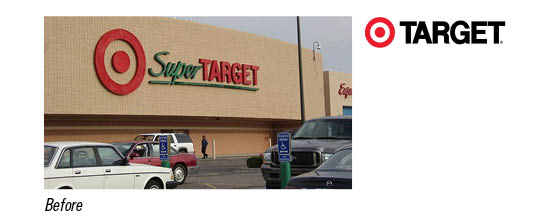

Rebranding To Maintain Relevancy Within The Market
Companies have to change with the markets and forces that shape buying decisions. We all remember the yellow pages. A very large book with yellow paper. As the online environment grew it rendered the Yellow Pages out of date, causing a sharp drop in business. To adapt, Yellow Pages went through a brand and product change. The new YP (Yellow Pages) has developed a stronger online presence adapting to the modern consumer’s needs. This shift has reinstilled life in their brand.
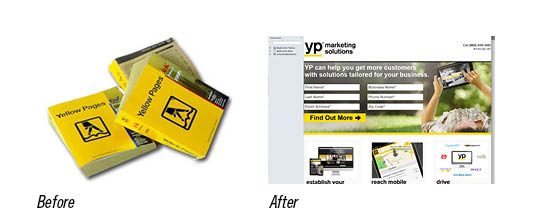
Rebranding Due To A shift in a companies goals, products or services
When a company loses market share and the customer base has changed its necessary to look at the existing brand through new eyes. Since 1975 Playboy Magazine circulation has dropped from 5.6 million to 800,000. “You’re now one click away from every sex act imaginable for free. And so it’s just passé at this juncture.” So said Playboy’s chief executive Scott Flanders as he explained that Playboy magazines will no longer feature naked photos.
Playboy’s rebranding is just starting and will adopt a cleaner, more contemporary style. The online readership has already gone up from 4 million unique users to 16 million. It will be interesting to see how Playboy, a traditional print brand, continues to evolve to adapt to it’s new online consumers’ needs.
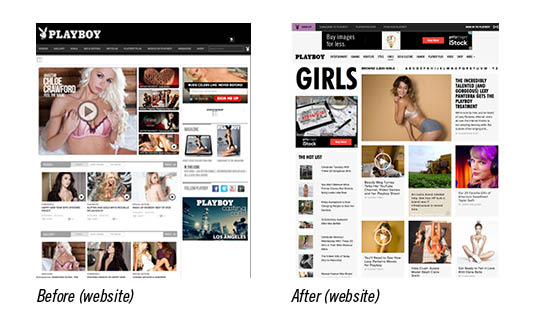
How To Start The Rebranding Process
Unlike the branding process, which is a fresh start without preconceived ideas, the company has to reinvent itself. To go through the rebranding process successfully a company must know itself, it’s personality, be honest and put egos aside. Working with a third party advertising and marketing agency can help remove some of the conflicting opinions and egos from the equation.
Here Are The First Steps Of The Rebranding Process:
1. Conduct Internal Research:
Start with these questions:
- What does the company, its employees and stakeholders think and feel about the current brand?
- What areas are in need of improvement?
2. Conduct External Research:
Start with this question:
- What does the market or potential clients think and feel about the current brand?
Create a competitive analysis starting with these questions:
- What’s happening in the industry?
- Who is your real competition?
- What is the competition saying and how are they saying it?
3. Agreement and buy-in from the management team:
Once you have done your internal and external research you will need to determine if there is a large enough need for a rebrand. If so, your next challenge is presenting your findings to management and getting buy-in. This is crucial, if you can’t get management buy-in then the rebranding process stops here.
4. Hire an Agency Skilled in Brand Development:
Put the responsibility on an advertising & marketing agency that understands the end goal and the process involved in building a strong brand. Choose a company who is not involved with the current day-to-day operations and doesn’t have an emotional investment or any ownership of the existing brand. A good agency can be unbiased and is capable navigating the political waters involved with rebranding process.
Once you’ve selected the right agency, the art of rebranding process can begin!
Sources:
- http://www.edibleapple.com/2009/04/20/the-evolution-and-history-of-the-apple-logo/
- http://www.chron.com/news/houston-texas/houston/article/Trademark-lawsuit-pushes-Mission-Burrito-to-5263169.php
- http://www.businessinsider.com/10-most-successful-rebranding-campaigns-2011-2?op=1
- http://creativepool.com/magazine/technology/yellow-pages-rebrand-will-they-make-a-comeback.3864
- http://www.entrepreneur.com/article/240346 (/sup)
